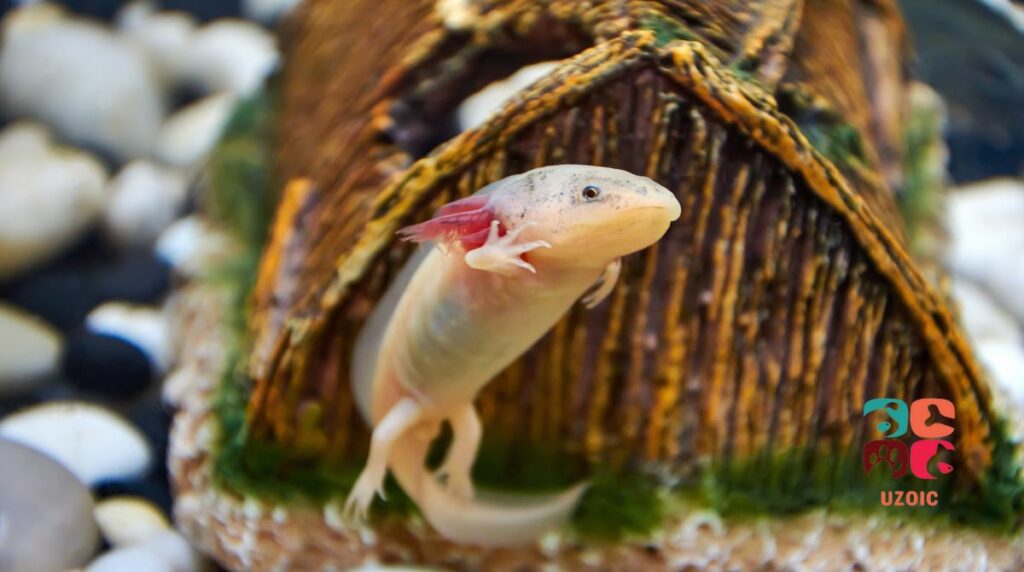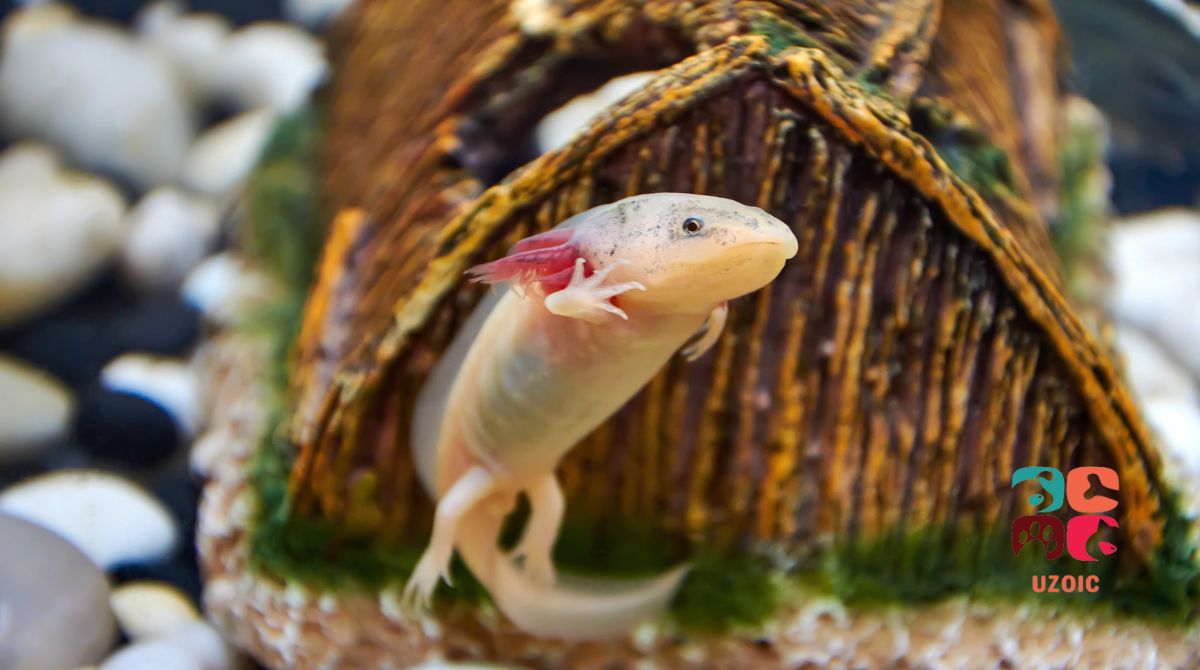Axolotls, also known as Mexican walking fish, are unique and fascinating creatures. They are the only species of salamander that can regenerate their limbs and breathe through their gills even when they are out of water. However, one common problem that axolotls face is shrinking gills.
Axolotls have grown in popularity as exotic pets in the United States recently. Most axolotls sold as pets are wild-caught and can be found in pet stores or online. When they are first brought home, they are usually around four inches long. However, they can grow to eighteen to twenty inches long.
Many axolotl owners notice that their pet’s gills start to shrink after a few months. This is because axolotls are adapted to living in stagnant water with low oxygen levels. In captivity, they are often kept in tanks with filtered water that has a higher oxygen content. This can cause their gills to shrink. In addition, in a well-oxygenated tank, the gills may lose their luster with time.
On the flip side, low oxygen levels in the tank can also cause the gills to shrink. If you notice your axolotl staying close to the surface a lot, it is most likely not getting enough oxygen from the water, which is why it is trying to get it from the air, causing the gills to start shrinking.
However, the leading cause of axolotl’s shrinking gills is poor water quality. If the water that your axolotl is living in is not clean, it can cause the gills to shrink. This is because the gills are very sensitive and can be damaged by toxins and pollutants in the water. High levels of Ammonia are the number one cause of axolotl gill shrinking noticed by axolotl owners. Further, any change in the PH levels of the tank water can also result in this phenomenon.
If you’re an axolotl owner, it’s important to know how to stop your axolotl’s gills from shrinking. In this article, we will discuss what causes axolotl gills to shrink and how you can prevent it from happening.
Table of Contents
Why Are My Axolotl Gills Shrinking?

If you notice that your axolotl’s gills are shrinking, it could indicate poor water quality. Ammonia and other pollutants can damage the delicate gills, causing them to shrink and eventually fall off. If you suspect that water quality is to blame, do a quick test of your tank’s ammonia levels. If they are high, perform a water change and monitor the levels closely in the future.
Another possible cause of shrinking gills is an infection. Gill parasites are fairly common in axolotls, and they can cause the gills to become inflamed and shrunken. Gills may drop off completely due to an infection.
More often than not, gill shrinkage is caused due to illness or bad husbandry.
If you notice any other symptoms, such as excessive mucus production or unusual behavior, take your axolotl to the vet for a diagnosis. In most cases, shrinking gills are treatable with medication.
My Axolotls Gills Not Feathery And Shrinking!
Not to worry! This is perfectly normal behavior for an axolotl. When they are first born, their gills are delicate and feathery. Then, as they grow older, their gills will become thicker and more club-like. During this time, you may also notice that your axolotl’s gills are shrinking. This is because their bodies are becoming more efficient at using oxygen from the water, so they don’t need such large gills anymore.
Do Axolotls Lose Gills?
No, axolotls do not lose their gills as they mature. Instead, they keep their gills throughout their lives and use them to breathe underwater. This ability to retain their gills into adulthood is known as neoteny, and it allows axolotls to live and thrive in aquatic environments. In addition to their gills, axolotls also have lungs, which they use when they are out of the water.
When they are submerged, however, the axolotls rely exclusively on their gills for oxygen. This unique respiratory system makes them well-adapted to life underwater and allows them to stay submerged for long periods of time.
Will Axolotl Gills Grow Back?
When an axolotl loses a gill, it will grow back. The regenerative ability of axolotls is truly amazing- they can regrow lost body parts and repair damage to their nervous system and heart.
In fact, axolotls have been known to regenerate amputated limbs, the spinal cord, heart, intestines, kidneys, and even parts of their brain. So, if an axolotl loses a gill, there’s no need to worry- it will regrow in time.
In multiple scientific studies published over time, scientists removed various organs from a group of axolotls and found that the animals could regenerate fully functional organs within eight weeks. The new organs were structurally similar to the originals, with well-developed blood vessels and filaments. Importantly, the regenerated gills allowed the axolotls to breathe underwater just as effectively as before.
These findings suggest that the axolotl’s ability to regenerate gills is remarkably robust. However, it is still unclear exactly how the animals are able to regrow such complex structures. Hopefully, further research will help to shed light on this fascinating process.
How Do You Promote Axolotl Gill Growth?
There are a few things you can do to promote axolotl gill growth.
Water Temperature: First, make sure the water temperature is between 68 and 72 degrees Fahrenheit. This is the ideal range for axolotls, and it will help to promote gill growth. Royal Veterinary College of London recommends an optimum temperature range of 60.8 °F – 64.4 °F.
Aquarium Size: Second, make sure the aquarium is large enough. Axolotls need plenty of space to move around and explore. A 20-gallon tank is a good size for one axolotl, but you may need a larger tank if you have multiple axolotls.
Water Quality: Third, keep the water clean. Ammonia and nitrite levels should be at 0ppm, and nitrate levels should be below 20ppm. Regular water changes will help to maintain water quality and promote gill growth.
Axolotl Food: Fourth, feed your axolotl a variety of live foods. Earthworms, Bloodworms, Blackworms, Salmon Pellets, and Brine Shrimp, are all good options. Live food will give your axolotl the nutrients they need to grow healthy gills.
Consult Vet: Consult with a veterinarian if you have concerns about your axolotl’s health.
Following these steps can help ensure that your axolotl has healthy gill growth.
Conclusion
This brings us to the conclusion of this article on how to stop your axolotl gills shrinking. If you notice that your axolotl’s gills are shrinking, it could be a sign of poor water quality, an infection, or simply a normal part of their development.
However, if you suspect water quality is to blame, do a quick test your tank’s ammonia levels. If they are high, perform a water change and monitor the levels closely in the future.
We hope that it has been helpful and informative. Thanks for reading!
You may like:
- The Ultimate Guide To Mosaic Axolotls
- Do Axolotls Sleep?
- 8 Signs Of A Healthy Axolotl
- How Do You Treat A Sick Axolotl?
- Do Axolotls Bite? The Truth About Their Biting Behavior
- Aquarium Chiller for Axolotl: Should you use it?


